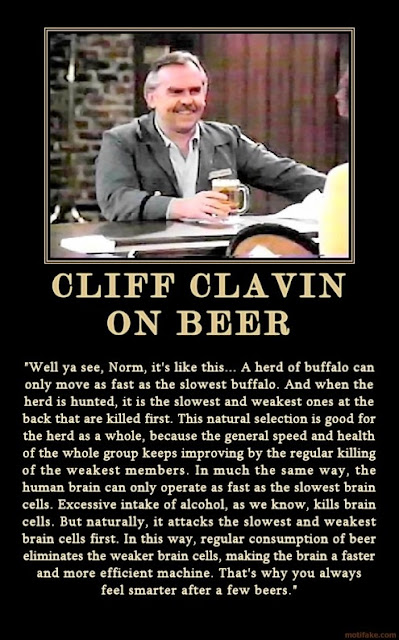Or, we could call it, “Did you know?”
 Our last post involved beer facts – some fun trivia to take to your local pub, amaze your friends, and score some major points in team trivia. Continuing that theme – let’s look at the other side of things. I’m sure you’ve heard things like:
Our last post involved beer facts – some fun trivia to take to your local pub, amaze your friends, and score some major points in team trivia. Continuing that theme – let’s look at the other side of things. I’m sure you’ve heard things like:
- Beer is best when served cold,
- Bottles are better than cans,
- Draft is better than bottles,
- Guinness in Ireland is better than Guinness here. (I’ve perpetuated this one myself.)
In today’s post, we dig deeper into these and many more. Let’s get to the real truth!
With all of the ‘false news’ today, it’s time to forget everything we thought we knew about beer.
MYTH I: Dark beer is higher in alcohol content than light beer.
FACT: I get it. They’re thicker, they have more flavor, they just HAVE to have more alcohol, right? It can certainly be that way, but you can’t depend on this as the sole determining factor.
Beer color comes from the type of grain and what has been done to that grain. Some grains are roasted and some beers add other caramelized ingredients to give it a deeper darker color.
A few examples:
- Guinness is the gold standard of super dark beers, right? About 4.2% alcohol.
- Tripels, one of the lighter colored Belgian beers (light straw color) usually run in the 8-10% range.
- Schwarzbier, literally translated to “black beer” is usually in the 4.5-5.5% range.
- A double IPA will usually be light in color, and again will be in the 8-10% arena.
Don’t judge a beer by it’s color!
MYTH II: Taking Aspirin before a night of drinking reduces hangover effects.
FACT: It’s a nice thought: Taking a pill now will help prevent feeling awful in the morning. Ultimately, it won’t help, and can actually be pretty dangerous.
The reality is, any pain medication will wear off before the real headache sets in the next morning. A word of caution: DO NOT TAKE aspirin or ibuprofen while still drinking. Painkillers can erode stomach lining, and that can cause liver damage. And irony sets in – this can cause more alcohol to actually make it to the bloodstream, exacerbating the problem! Pop those pills the next morning with no worries. And yes, it should help. Of course, you could also just have one or two fewer beers and enjoy what beer’s really all about – community and fellowship wth friends and family – not getting hammered and doing things (or people) you’ll regret. A Public Service Announcement from BabyGotBeer …
MYTH III: Light beer is healthier. Watch any Mich Ultra commercial and see some lithe millenials running ultra-marathons and then bringing a sixer over to a friend’s house.
FACT: Yes, they typically have fewer calories, so I guess you can say they’re healthier, or maybe less unhealthy. But the fact is, when people are having the lighter beers, they often end up having more of the lighter beers and consuming more calories than if they’d had two super heavy beers. Here’s some math.
Bud Light is approximately 140 calories for a bottle.
Samuel Smith Organic Chocolate Stout has 220.
I’ll happily have two of my SSOCS for 440 calories, and you feel free to knock back four Bud Lights. We’ll both enjoy our evenings and our drinks of choice, but I’ll go home 120 calories lighter. It’s not just all about the calories. And besides – who’s drinking beer for their health anyway? Come on, Mich Ultra – stop trying to act like you’re the healthy alternative. Now, if you REALLY want to discuss the health benefits of beer …
MYTH IV: Alcohol kills brain cells.
FACT: It may impair your thinking, but alcohol doesn’t permanently destroy brain cells. It damages dendrites, which are the little feelers on neurons that convey electrical messages from your brain to your body. Neurons are the cells that act as communicators, triggering motor responses to physical stimuli. For example, if you touch something hot, neurons carry the message from your nerves to your brain, which send the return message to your arm to move your hand off the stove. Dendrite damage interferes with those messages, which can account for all those poorly spelled texts and inability to walk in a straight line (But the effects are not permanent.) That being said, it’s important to note that persistent alcohol abuse can indirectly contribute to lasting defects, since alcoholism is often accompanied by other poor health habits like poor nutrition. Overuse of alcohol combined with a lack of nutrients can lead to memory lapses and problems with motor coordination.
MYTH V: Bottles are better than cans.
FACT: Maybe decades and decades ago when cans didn’t have the proper lining and gave their liquid contents a tinny, metallic taste. But not in modern times. Many people still assume that glass is preferable, but the fact is, they do not protect beer as well as the good ole fashioned can.
Ultra-violet rays do lots of things we’d like to avoid. Sunburn … and skunking a beer. Sunlight damages beer. If you have to go with bottles, stay with the darkest possible. Brown is better than green is better than clear. The less light that gets to your beer the better. Enter the can. No light gets through the can, and that’s a good thing!
The other enemy, in this case, is oxygen. Screw tops and even pop tops can let tiny amounts of air into them, which speeds the rate of decline of a beer’s quality. Not so for cans. If there’s still a stigma at your next party, pour that can into a glass, which is a better way to enjoy it anyway!
MYTH VI: Aging makes beer better.
FACT: Cellaring beer, if done properly, can be great and very rewarding. It doesn’t make beer
better, per se. It just makes it different. Now, if you’re aging some watered-down light beer, nothing much will change over time. There isn’t much reason to store that vintage December 2016 Miller Lite. But if you come across a barrel-aged quad, cellaring can do some interesting things.
Again – it won’t make it better, it’ll just make it different. It would be very interesting to taste the subtle differences between the same beer 1, 2, 3 years apart. Different flavors will intensify. Others may diminish or even disappear. The point is, the beer is going to be great as soon as you get it home. It will still be very good if you have it two years later, it’ll just have a different flavor profile. Experiment and see what works for you!
MYTH VII: Draft beer is better than bottled beer.
FACT: This is more of a yes and no question. It really depends on your beer hall. If a bar or other
serving establishment properly maintains their draft lines, draft beer is the best and freshest you can get. No light will ever penetrate a keg, and the keg has likely been stored properly, leading to a better experience.
If, however, the bar doesn’t clean and maintain their lines, bad things happen. This is nothing that will make you physically ill, it’ll just make your beer taste like anything other than what it’s supposed to be.You know that smell in a bar? That SMELL – like those dirty bar mats when they haven’t been cleaned? That’s bacteria. (Acetobacter, to be exact.) If it’s on the bar mats, it wouldn’t be shocking to find it in the draft lines too. Again, it won’t make you sick, but it will alter the flavor of your beer.
If it smells skunky in the bar – stick to bottles. If it’s a reputable establishment and you have some level of confidence that they take care of their draft system – go with draft. It’s your best bet.
MYTH VIII: If you buy beer warm, store it warm. Once it’s been cooled, it cannot get warm or it’s skunky.
FACT: There is nothing factual about this. The fact is, beer starts aging the second it leaves the factory. Beer stored warmer than it should be hastens the aging process. Oxygen and light are the enemies of beer. While there is some slight oxygenation of beer based on rising and falling temperatures, it doesn’t cause more of a problem than storing beer in a warm place.
If you see a package store that stores the majority of their beer in a warm place … be concerned. Ask them how often their stock turns over. There is nothing worse than buying your favorite brew and opening the first one only to find it’s been skunkified. Yes, it’s a word.
MYTH IX: All beer is best when served cold.
FACT: I think the correct response to this is … NO NO NO NO NO NO NO NO NO NO NO NO NO NO NO NO NO NO NO NO NO NO NO NO NO NO NO NO NO NO NO NO NO NO NO NO!!!!
I think that’s the right number of NO’s.
If only some enterprising beer blogger had created a handy temperature chart to help you know the right temperature for serving different types of beers …
Any questions?
MYTH X: Guinness in Ireland is better than Guinness in the states.
FACT: I’ll admit it; I’m guilty of this one myself. I’ve been to Ireland and toured the brewery at St. James Gate. (If you go to Dublin – it’s a must! The 360 degree view of Dublin from the top floor, with a fresh pint in hand … nothing like it!) And the Guinness I had in Ireland was stellar. It just
had to be a different beer, right?
As it turns out … no. It’s all the same lovely stuff. Part of the myth comes from sentimental reasons. You just feel like it’s better because you’re THERE. And perhaps there are some small reasons why Guinness might be slightly better in Dublin, Ireland than in Dublin, Georgia. The kegs probably turn over there much faster. And delivery of product is obviously as quick as possible. You’re getting the freshest Guinness possible while there. And it’s also likely that the person pouring it has better skill in how to properly do it. All of those factors could lead to a very slight upgrade in flavor, but it’s not brewed differently – it isn’t a different version. It’s all the same ole delicious stuff.
Any other myths you’d like us to address?
 Our last post involved beer facts – some fun trivia to take to your local pub, amaze your friends, and score some major points in team trivia. Continuing that theme – let’s look at the other side of things. I’m sure you’ve heard things like:
Our last post involved beer facts – some fun trivia to take to your local pub, amaze your friends, and score some major points in team trivia. Continuing that theme – let’s look at the other side of things. I’m sure you’ve heard things like:



Nice read! Thanks for the information.More power to your blogging career